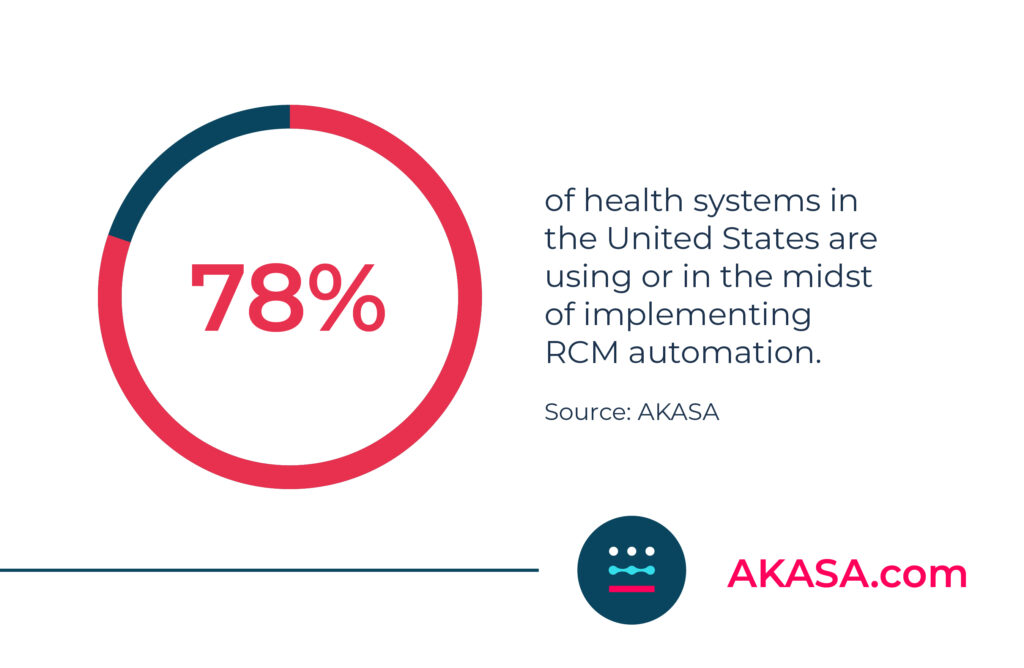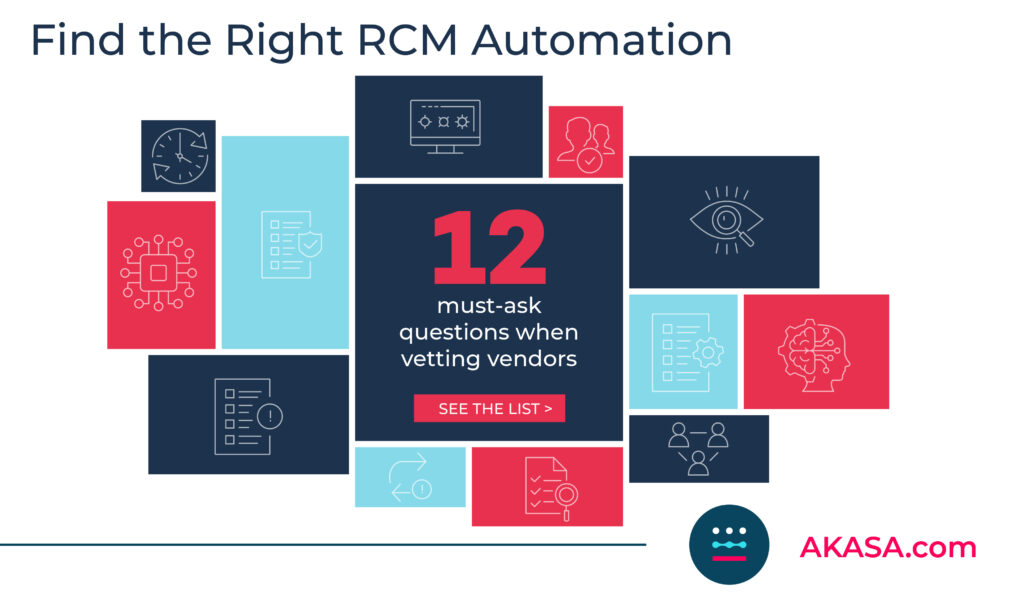The Gist
Many healthcare teams recognize the importance of implementing automation for their revenue cycle management (RCM). After all, RCM automation can help reduce costs, increase staff productivity, and boost revenue. Yet often, IT isn’t included in the early conversations around RCM automation. As a technology leader, your department has the knowledge required to vet automation vendors for technology fit, security, and more. To identify and implement the right RCM automation, your team should ask specific questions upfront and when vetting potential technology vendors to ensure you’re setting your organization up for success.
RCM leaders at your organization are discussing automation. Period.
The healthcare revenue cycle is fighting non-stop battles. Staffing challenges are (still) a problem, while healthcare demands show no signs of slowing down. On top of this, prior auth requests are on the rise, taking up precious staff time.
With all the above in mind, it’s no surprise RCM automation is experiencing a popularity boost. In fact, 78% of health systems in the United States are using or in the midst of implementing RCM automation.

Just as RCM automation is increasingly popular within healthcare organizations, it’s also popular as a business model. With more than 260 RCM companies out there, finding the right one is no small feat.
An RCM automation provider should meet your specific needs, be compliant with industry standards, and integrate with your existing system. Not to mention, you need to consider EHR and payer compatibility.
As a technology leader at your healthcare provider, you’re uniquely qualified to vet RCM automation vendors for numerous critical elements. By asking the right questions, you can help determine system compatibility, if the vendor’s cybersecurity measures are up to par, and more. These efforts can amount to time well spent. Between your RCM leaders and your IT expertise, you can each vet prospective vendors for RCM workflow compatibility and system/security compliance.
Healthcare IT teams need to be cognizant of many things when considering automation for their revenue cycle operations. If they’re working with Epic as their EHR, for example, there are implications on how they need to schedule upgrades of Epic as they plan automation. It’s important that the automation solution fits into their existing infrastructure and can be easily integrated — without disrupting everything.
~ Shankar Rao, Engineering Manager for Client Solutions at AKASA
PART 1: IT Considerations Before Embarking on Your Automation Journey
Before your organization starts shopping around for an RCM automation vendor, there are pre-automation considerations. While your RCM leaders have their own vendor-related questions and concerns to address, there are some IT-specific items to cover before automation.
1. Should I build an automation solution in-house or buy one from an external technology vendor?
When considering different options for RCM automation, some RCM leaders might wonder, “Should we just build the software ourselves?”
While a valid question, building automation in-house presents a number of hoops to jump through, especially where IT is concerned. Let’s look at some pros and cons of working with an external partner vs. building in-house.
There can be some advantages to building a solution internally with your IT team, such as creating a highly customized system, having full control over the final product and updates to it, and keeping proprietary information and data in-house.
However, upon taking a closer look, the number of downsides when building in-house outweigh the many pros of going with a trusted vendor.
For example, technology vendors often have more extensive talent resources specializing in the latest artificial intelligence (AI) and machine learning (ML) innovations. The average base salary for an ML engineer salary is more than $150,000, so building an in-house team of experts gets expensive quickly. They’re also equipped with the latest technology and best practices to navigate the fast-paced healthcare industry’s intricacies and ever-changing rules and regulations.
When working with an external partner to bring in an AI and automation solution, you can stay focused on your mission and driving outcomes within your organization. It also allows for a much faster implementation than building something from scratch in-house. The external technology will be more flexible and scalable as your health system grows and IT needs evolve.
Lastly, when building in-house, maintenance and updates fall on your team. Depending on your IT infrastructure, that can be time-consuming, costly, and ineffective at worst. A third-party RCM automation vendor, on the other hand, will likely deliver better support while giving your department time to focus on more important, in-house matters.
In most cases, you’re better served working with a trusted AI and technology partner who can provide a proven and flexible solution for your specific needs and serve as an extension of your IT team — being deeply involved in the process and delivering a significant ROI.
2. If I decide to bring in a technology partner, what type of automation is best?
As mentioned before, there are countless RCM automation vendors, with more entering the market all the time. No two vendors are the same, with many taking different approaches to automation.
While your RCM leaders are possibly familiar with some automation technology, your team’s knowledge of your various systems and security requirements allows you to consider each technology type from a different perspective.
One type of technology that’s often used for automation — although not just in healthcare but across various industries — is robotic process automation (RPA). With RPA, the vendor builds a bot for each step of a specific RCM process.
RPA is effective when dealing with linear, simple tasks. However, with the dynamic nature of healthcare operations, it often comes up short. RPA can’t adapt to minor changes in payer portals, EHRs, and other areas.
For example, a button or field that changes location can break an RPA bot, leading to expensive and often unexpected maintenance costs — during which work is paused. This same maintenance can also result from updates to your EHR, payer portals, and other systems. And you know that those happen often.
Instead, consider a solution that adapts to changes in real time and requires little to no maintenance, which gives your team peace of mind that tasks are getting done.
For example, AKASA uses generative AI (GenAI) and large language models (LLMs), in combination with our RCM experts to provide robust and resilient streamlining for the revenue cycle. If the system runs into outliers or changes, it flags our RCM experts, who resolve it while teaching the AI to handle it correctly the next time it occurs.
The unique AKASA approach allows the GenAI-powered solution to scale in ways other applications can’t and alleviates the burden on healthcare IT teams who don’t have to worry about maintenance or system downtime.
3. Should I outsource or offshore my revenue cycle operations?
When discussing RCM automation, both outsourcing and offshoring often come up. As an IT leader, it’s important to recognize the unique challenges outsourcing and offshoring bring.
Some hospitals outsource their entire revenue cycle department to a third party vendor that leverages their own staff and technologies to perform the same tasks. Most, if not all, roles and responsibilities are transferred to the outsourcing company.
Some outsourcing vendors are based in the United States, with U.S.-based talent. Some rely on off-shore talent to do the work.
Outsourcing or offshoring may save your organization money, but it also requires your team to figure out how to handle security clearance. This can make it more difficult to identify potential cybersecurity threats, make it harder to achieve certain compliances, and put your patient data at risk.
You have to consider implications for this type of vendor’s security protocols, particularly around PHI. If they don’t specialize in healthcare or RCM, there may be nuances they aren’t aware of that could put your data at risk.
By outsourcing your entire RCM department, you’re going all-in on the vendor’s services. You’re releasing an entire team from their duties and trusting that the vendor is going to meet your needs. If for some reason things don’t work out, you’ll need to start from scratch and build a new team.
By keeping RCM operations in-house and bringing in a trusted partner to help automate manual tasks and workflows, you have more control over your data, process, and people. Just ensure your vendor uses the highest security standards and that your team is involved throughout the entire process.
PART 2: Questions To Ask When Vetting Technology Vendors
Once you’ve decided you want to work with an RCM automation vendor, it’s time to vet each one before selecting the right partner. The following questions can make the vetting process easier and help you get the IT-related information you need to make an educated decision. 
1. Is the vendor’s AI solution secure and compliant with industry standards?
As you know, security is a top concern in both the healthcare and technology worlds. One of the most important questions you should ask vendors is if their technology’s security infrastructure is HIPAA-compliant and meets/exceeds security standards. With sensitive PHI involved, the vendor must take security and data protection seriously.
Ask about the vendor’s security measures and certifications at the very beginning to ensure compliance with HIPAA-mandated security protocols and the safety of your patient’s data. If the vendor isn’t checking the right boxes with security, any following questions are moot.
For example, the AKASA platform is HIPAA-compliant, with infrastructure built on a foundation of the highest security standards — HITRUST CSF, SOC 2, NIST Cyber Security Framework, and CIS, to name a few. We employ ZeroTrust VPN and FIPS 140-2 compliant data-at-rest and data-in-transit encryption protocols and keys, and all our security runs on Amazon’s secure AWS infrastructure.
2. What is the vendor’s technology expertise?
Who is behind the technology? Who are the engineers involved, and what is their academic and experiential background? Ask to speak with the chief technology officer at the vendor and any engineering leadership who might be involved in handling your account.
What is their understanding of the workflows? What updates are they making to the technology? How are they incorporating the latest innovations?
You need to trust your partner and the expertise they bring to the table. And healthcare IT leadership is often uniquely qualified to ask questions that RCM leadership may not consider.
Read about how the AKASA VP of engineering and co-founder runs a successful engineering team.
3. Is their automation technology compatible with our current IT infrastructure?
It’s not uncommon for healthcare systems to utilize a wide number of systems, many of which may not integrate. This is a giant IT interoperability headache, even without throwing automation into the mix.
In fact, nearly 60% of health IT leaders say they’re using between 50 and 500 solutions for their healthcare operations, with almost a quarter using more than 150.
Of those health IT leaders, 88% say those various incompatible systems make their jobs more complicated, cause increased stress and burnout, and lead to less time to focus on innovation, among other issues.
Therefore, it’s important to assess upfront how the technology vendor works, what resources are required from both sides, and how the new technology will integrate with your health system’s existing tools and EHR.
If you’re using several independent solutions already, the vendor’s automation may not be compatible with all of them, so it’s important to clarify this early on.
4. How much work does the vendor’s maintenance ask of our team?
Automation is on ongoing process. It takes time. The process can vary from vendor to vendor, and so can the support. While some vendors carry most of the burden, others ask a lot of your team.
Ask how much work you’ll need to do internally to maintain the automation?
When vetting vendors, ask about their maintenance process. What kind of system access and security clearance do they require? How do they handle updates to their automation?
To ensure a successful partnership and avoid any surprises or roadblocks, have an open and clear discussion about these details with the vendor. Align on deliverables and expectations from the onset. There’s no getting around the maintenance process, but asking these questions can help you avoid a vendor that puts too much burden on your team.
5. Is the vendor’s technical background and support up to par?
Finding an automation vendor with a healthcare background is a huge plus, as they can help your organization make informed decisions about where to scale automate next, and so on. But equally important is the vendor’s technical background and support.
Ask the vendor about their type of automation and technical experience. Do they have case studies or examples of clients they’ve helped? If so, what kind of automation was used, what were the results, and what was the overall implementation process like?
And even better — is there anyone at your organization who knows a health system that has worked with this vendor?
Similarly, ask about their support process. If something goes wrong or breaks with the automation, do you have to submit a ticket or handle the issue yourself? If you submit a ticket, what’s the standard turnaround time? How involved does your team have to be following a ticket submission — do you handle the fix the problem per their instructions, or do they take over?
Best practices for vetting an AI provider include meeting the team to gauge if their experience is up to scratch. This helps both the vendor and health IT teams establish a ground-floor understanding of your needs, and the roles each will serve as you carve out your automation possibilities. You may even loop in their EHR contact on a call to get the ball rolling with all of your stakeholders in alignment with how a proposed implementation will occur.
~ Shankar Rao, Engineering Manager for Client Solutions at AKASA
A quality RCM automation vendor should deliver great support and bear as much of the burden as possible. This allows your team to focus on internal IT matters and other projects. After all, the point of automation is to save time, not eat it up.
Read more about the nine things to look for when selecting an RCM automation provider.
PART 3: Requirements To Implement a New RCM Automation Solution
Once you decide on an automation vendor, ask these questions ahead of implementation to ensure deployment goes smoothly. This will allow you to kick off faster and see value faster.
1. Who are the key decision-makers involved in the implementation process, and what actions are required on our end?
While you already asked broadly about what system access is required during the vetting process, now is the time to get more granular. Ask who exactly on your team will be in charge of providing the necessary authorization, data, and system access for the AI vendor.
This is a crucial make-or-break component that often delays the implementation of the new solution.
Oftentimes, decision-makers at the CIO or CTO level will be heavily involved in selecting a vendor, leaving their IT teams relatively in the dark until a vendor comes in requesting access to the systems and sensitive data they’re tasked with protecting.
Getting access to the network owners who can allow us into their systems expedites the process. In many cases, the owner agrees to take on additional risk based on understanding how the technology will help workflows. However, suppose they’re late to the conversation or don’t have the ability to have their questions answered early. In that case, they can be hesitant to provide the access needed to let the technology do its work and provide the assistance the RCM organization needs.
~ Shankar Rao, Engineering Manager for Client Solutions at AKASA
2. How will we measure the success and ROI of the new RCM automation solution?
It’s essential to align with your new automation partner and internal teams upfront on which soft and hard ROI measurements to track. Ensure that your new partner is also capable of and willing to measure ROI in a way that accurately captures the full impact of automation and AI on your RCM.
It’s also vital you have current metric tracking capabilities in place within your organization. If your organization’s RCM department is focused on tracking how automation helps their queues, does your existing tech stack support in-depth tracking? If not, how difficult will it be for you to implement this? And is your prospective automation vendor able to help you?
Tracking metrics is critical to understanding your organization’s RCM performance, as well as your automation efforts. But current ROI best practices often lack a holistic view, mostly looking at hard financial metrics rather than the broader implications automation has on a health system’s efficiency, compliance, patient engagement, and RCM staff.
Clear communication and collaboration across all internal and external teams around which soft and hard ROI measures to track are crucial in assessing the success of your RCM automation solution over time. And this will ultimately help you make more informed technology decisions across the board.
Learn more about how you can evaluate your automation efforts and which metrics to track.
An RCM Automation Vendor Who Prioritizes Technology and Security
Finding an RCM automation vendor that checks all the right IT and RCM boxes is no easy task. Fortunately, the unique AKASA platform is capable of doing both.
Our platform is built on a foundation of industry-leading security, backed by RCM experts, and leaves virtually no burden on either you or the revenue cycle team.
We combine GenAI with LLMs and a team of RCM experts to offer a unique approach that allows us to streamline end-to-end RCM tasks, while the solution learns as it goes. When it hits a snag, our team steps in and fixes it, while our RCM experts complete the work. There’s little IT or RCM burden for your organization — the work gets done.
Schedule a consultation to see how AKASA can help you streamline your RCM operations with none of the IT headaches for your team.











